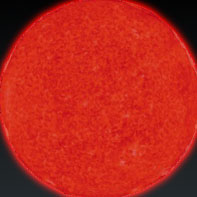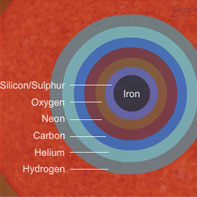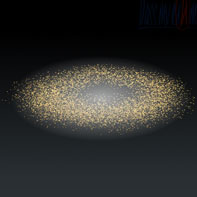Death of Very High Mass Stars
For very massive stars with a mass greater than 10 solar masses, there is no mechanism to stop the contraction by gravitational forces after the nuclear fusion reactions stop. The pull of gravity is so strong that it even overcomes the repulsion forces between the electrons, protons and neutrons in the atoms. The density of the star become infinite and its volume zero, a state referred to as singularity. The gravitational field surrounding this remaining star is so high that no matter or radiation (including light) can escape. With no escaping particles or radiations due to the immense gravity the star appears black, hence the name black hole.
The animation below shows the death of a very high mass star resulting in a black hole.
High Mass Star |
 High mass stars are those with a mass greater than 3 solar masses or in other words three time more massive than our sun. Although these stars have more hydrogen fuel to consume the sequence of events is much faster. The hydrogen burning takes place at a high rate to maintain the pressures to counteract the gravitational attractive forces. This results in the stars attaining higher temperatures and appearing brighter than low mass stars. For a black hole to form from a high mass star its mass needs to be greater than 10 solar masses. High mass stars are those with a mass greater than 3 solar masses or in other words three time more massive than our sun. Although these stars have more hydrogen fuel to consume the sequence of events is much faster. The hydrogen burning takes place at a high rate to maintain the pressures to counteract the gravitational attractive forces. This results in the stars attaining higher temperatures and appearing brighter than low mass stars. For a black hole to form from a high mass star its mass needs to be greater than 10 solar masses.
|
Red Supergiant |
 For stars with a mass greater than 10 solar masses after the hydrogen and helium run out the star cools and contracts under the influence of the gravitational forces and the nuclear fusion cycle in these stars continues. The gravitational potential energy from the mass of the star causes extremely high temperatures (about 170 million degrees Celsius) to build up in the core. This triggers further nuclear fusion of heavier elements causing the outer layer of the star to expand to about 100 times its original diameter forming a red supergiant. A red supergiant can have a radii 1500 times that of our sun. Due to the expansion of the outer layers the energy from the hydrogen layer is spread over a larger surface area resulting in a lower surface temperature and a shift in the stars light output to a red wavelength. For stars with a mass greater than 10 solar masses after the hydrogen and helium run out the star cools and contracts under the influence of the gravitational forces and the nuclear fusion cycle in these stars continues. The gravitational potential energy from the mass of the star causes extremely high temperatures (about 170 million degrees Celsius) to build up in the core. This triggers further nuclear fusion of heavier elements causing the outer layer of the star to expand to about 100 times its original diameter forming a red supergiant. A red supergiant can have a radii 1500 times that of our sun. Due to the expansion of the outer layers the energy from the hydrogen layer is spread over a larger surface area resulting in a lower surface temperature and a shift in the stars light output to a red wavelength.
|
Red Supergiant Interior |
 The reason for nuclear fusion after hydrogen and helium is because the gravitational potential energy from the mass of the star causes extremely high temperatures to build up deep in the interior of the star giving the nuclei greater kinetic energy. They can overcome their mutual electrostatic repulsion allowing heavier elements such as carbon to undergo nuclear fusion to produce oxygen, neon, silicon, sulphur and finally iron. Iron has the most stable nucleus of nuclear matter; no further energy can be gained from its fusion. The reason for nuclear fusion after hydrogen and helium is because the gravitational potential energy from the mass of the star causes extremely high temperatures to build up deep in the interior of the star giving the nuclei greater kinetic energy. They can overcome their mutual electrostatic repulsion allowing heavier elements such as carbon to undergo nuclear fusion to produce oxygen, neon, silicon, sulphur and finally iron. Iron has the most stable nucleus of nuclear matter; no further energy can be gained from its fusion.
|
Supernova |
 With no further nuclear reactions supplying heat energy to push outwards and balance the immense gravitational forces, the star begins to collapse. After the end of the nuclear burning stage if the mass of the star is greater than 3 solar masses, further collapse of the iron core continues under the immense force of gravity. The gravitational forces are so strong that they provide enough force for the iron nuclei to overcome their electrostatic forces to become a rigid high density core. The formation of this rigid core happens rapidly. The collapse of the star is dramatically halted and the infalling material bounces off the core and up towards the star’s surface. This sudden bounce produces a shockwave of tremendous energy ejecting material and high energy particles (neutrinos) at high speeds. This massive explosion is called a supernova and during this short period the supernova can outshine a whole galaxy. It is from supernovae that the heavier elements such as carbon and oxygen are present in the universe. With no further nuclear reactions supplying heat energy to push outwards and balance the immense gravitational forces, the star begins to collapse. After the end of the nuclear burning stage if the mass of the star is greater than 3 solar masses, further collapse of the iron core continues under the immense force of gravity. The gravitational forces are so strong that they provide enough force for the iron nuclei to overcome their electrostatic forces to become a rigid high density core. The formation of this rigid core happens rapidly. The collapse of the star is dramatically halted and the infalling material bounces off the core and up towards the star’s surface. This sudden bounce produces a shockwave of tremendous energy ejecting material and high energy particles (neutrinos) at high speeds. This massive explosion is called a supernova and during this short period the supernova can outshine a whole galaxy. It is from supernovae that the heavier elements such as carbon and oxygen are present in the universe.
|
Black Hole |
 With massive stars after the supernova explosion, the remaining core continues to collapse under the immense gravitational force. The compression by gravity is so strong that it can not only overcome the repulsion created by forcing electrons together, as is the case in neutron stars, but it even overcomes the repulsion of compressing neutrons and protons. Gravity crushes the core to such an extent that the density becomes infinite and the volume of the core zero. This state of matter is called singularity and cannot be explained by the laws of physics as we understand them. The gravitational field surrounding a black hole is so high that no radiation including light can escape it. For this reason they appear black and hence the name black hole. With massive stars after the supernova explosion, the remaining core continues to collapse under the immense gravitational force. The compression by gravity is so strong that it can not only overcome the repulsion created by forcing electrons together, as is the case in neutron stars, but it even overcomes the repulsion of compressing neutrons and protons. Gravity crushes the core to such an extent that the density becomes infinite and the volume of the core zero. This state of matter is called singularity and cannot be explained by the laws of physics as we understand them. The gravitational field surrounding a black hole is so high that no radiation including light can escape it. For this reason they appear black and hence the name black hole.
|

 High mass stars are those with a mass greater than 3 solar masses or in other words three time more massive than our sun. Although these stars have more hydrogen fuel to consume the sequence of events is much faster. The hydrogen burning takes place at a high rate to maintain the pressures to counteract the gravitational attractive forces. This results in the stars attaining higher temperatures and appearing brighter than low mass stars. For a black hole to form from a high mass star its mass needs to be greater than 10 solar masses.
High mass stars are those with a mass greater than 3 solar masses or in other words three time more massive than our sun. Although these stars have more hydrogen fuel to consume the sequence of events is much faster. The hydrogen burning takes place at a high rate to maintain the pressures to counteract the gravitational attractive forces. This results in the stars attaining higher temperatures and appearing brighter than low mass stars. For a black hole to form from a high mass star its mass needs to be greater than 10 solar masses.  For stars with a mass greater than 10 solar masses after the hydrogen and helium run out the star cools and contracts under the influence of the gravitational forces and the nuclear fusion cycle in these stars continues. The gravitational potential energy from the mass of the star causes extremely high temperatures (about 170 million degrees Celsius) to build up in the core. This triggers further nuclear fusion of heavier elements causing the outer layer of the star to expand to about 100 times its original diameter forming a red supergiant. A red supergiant can have a radii 1500 times that of our sun. Due to the expansion of the outer layers the energy from the hydrogen layer is spread over a larger surface area resulting in a lower surface temperature and a shift in the stars light output to a red wavelength.
For stars with a mass greater than 10 solar masses after the hydrogen and helium run out the star cools and contracts under the influence of the gravitational forces and the nuclear fusion cycle in these stars continues. The gravitational potential energy from the mass of the star causes extremely high temperatures (about 170 million degrees Celsius) to build up in the core. This triggers further nuclear fusion of heavier elements causing the outer layer of the star to expand to about 100 times its original diameter forming a red supergiant. A red supergiant can have a radii 1500 times that of our sun. Due to the expansion of the outer layers the energy from the hydrogen layer is spread over a larger surface area resulting in a lower surface temperature and a shift in the stars light output to a red wavelength. The reason for nuclear fusion after hydrogen and helium is because the gravitational potential energy from the mass of the star causes extremely high temperatures to build up deep in the interior of the star giving the nuclei greater kinetic energy. They can overcome their mutual electrostatic repulsion allowing heavier elements such as carbon to undergo nuclear fusion to produce oxygen, neon, silicon, sulphur and finally iron. Iron has the most stable nucleus of nuclear matter; no further energy can be gained from its fusion.
The reason for nuclear fusion after hydrogen and helium is because the gravitational potential energy from the mass of the star causes extremely high temperatures to build up deep in the interior of the star giving the nuclei greater kinetic energy. They can overcome their mutual electrostatic repulsion allowing heavier elements such as carbon to undergo nuclear fusion to produce oxygen, neon, silicon, sulphur and finally iron. Iron has the most stable nucleus of nuclear matter; no further energy can be gained from its fusion. With no further nuclear reactions supplying heat energy to push outwards and balance the immense gravitational forces, the star begins to collapse. After the end of the nuclear burning stage if the mass of the star is greater than 3 solar masses, further collapse of the iron core continues under the immense force of gravity. The gravitational forces are so strong that they provide enough force for the iron nuclei to overcome their electrostatic forces to become a rigid high density core. The formation of this rigid core happens rapidly. The collapse of the star is dramatically halted and the infalling material bounces off the core and up towards the star’s surface. This sudden bounce produces a shockwave of tremendous energy ejecting material and high energy particles (neutrinos) at high speeds. This massive explosion is called a supernova and during this short period the supernova can outshine a whole galaxy. It is from supernovae that the heavier elements such as carbon and oxygen are present in the universe.
With no further nuclear reactions supplying heat energy to push outwards and balance the immense gravitational forces, the star begins to collapse. After the end of the nuclear burning stage if the mass of the star is greater than 3 solar masses, further collapse of the iron core continues under the immense force of gravity. The gravitational forces are so strong that they provide enough force for the iron nuclei to overcome their electrostatic forces to become a rigid high density core. The formation of this rigid core happens rapidly. The collapse of the star is dramatically halted and the infalling material bounces off the core and up towards the star’s surface. This sudden bounce produces a shockwave of tremendous energy ejecting material and high energy particles (neutrinos) at high speeds. This massive explosion is called a supernova and during this short period the supernova can outshine a whole galaxy. It is from supernovae that the heavier elements such as carbon and oxygen are present in the universe. With massive stars after the supernova explosion, the remaining core continues to collapse under the immense gravitational force. The compression by gravity is so strong that it can not only overcome the repulsion created by forcing electrons together, as is the case in neutron stars, but it even overcomes the repulsion of compressing neutrons and protons. Gravity crushes the core to such an extent that the density becomes infinite and the volume of the core zero. This state of matter is called singularity and cannot be explained by the laws of physics as we understand them. The gravitational field surrounding a black hole is so high that no radiation including light can escape it. For this reason they appear black and hence the name black hole.
With massive stars after the supernova explosion, the remaining core continues to collapse under the immense gravitational force. The compression by gravity is so strong that it can not only overcome the repulsion created by forcing electrons together, as is the case in neutron stars, but it even overcomes the repulsion of compressing neutrons and protons. Gravity crushes the core to such an extent that the density becomes infinite and the volume of the core zero. This state of matter is called singularity and cannot be explained by the laws of physics as we understand them. The gravitational field surrounding a black hole is so high that no radiation including light can escape it. For this reason they appear black and hence the name black hole.